The Veterinary Faecal Filters Market is estimated to be valued at USD 1.3 billion in 2025 and is projected to reach USD 3.0 billion by 2035, registering a compound annual growth rate (CAGR) of 8.7% over the forecast period.
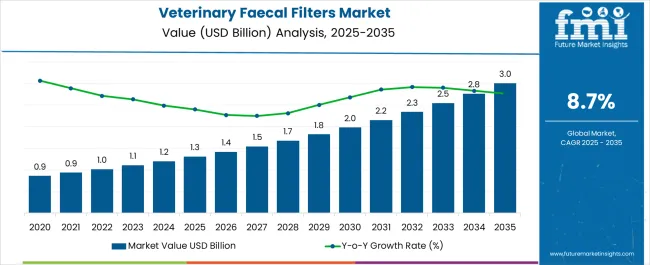
| Metric | Value |
|---|---|
| Veterinary Faecal Filters Market Estimated Value in (2025 E) | USD 1.3 billion |
| Veterinary Faecal Filters Market Forecast Value in (2035 F) | USD 3.0 billion |
| Forecast CAGR (2025 to 2035) | 8.7% |
The Veterinary Faecal Filters market is experiencing steady growth, driven by increasing demand for hygiene and biosecurity measures in veterinary facilities and livestock management. The adoption of faecal filtration systems is being supported by the growing emphasis on disease prevention, infection control, and sanitation in veterinary hospitals, clinics, and animal care centers. These filters help in maintaining clean environments, reducing the risk of pathogen transmission, and ensuring compliance with hygiene regulations.
Technological advancements in filtration materials and design have enhanced efficiency, durability, and ease of maintenance, which has further strengthened adoption. Growing awareness among veterinarians, livestock owners, and animal care providers about operational hygiene and animal welfare is accelerating demand.
Additionally, the increasing prevalence of zoonotic diseases and stricter veterinary hygiene regulations are driving investments in effective filtration solutions As veterinary hospitals, clinics, and research centers continue to prioritize biosecurity and operational efficiency, the market is expected to sustain growth, with innovative, high-performance faecal filtration products playing a key role in expanding adoption across the sector.
The veterinary faecal filters market is segmented by product type, end user, and geographic regions. By product type, veterinary faecal filters market is divided into Contrate Fecal Filters, Parasep Faecal Filters, and Others. In terms of end user, veterinary faecal filters market is classified into Veterinary Hospitals and Veterinary Clinics. Regionally, the veterinary faecal filters industry is classified into North America, Latin America, Western Europe, Eastern Europe, Balkan & Baltic Countries, Russia & Belarus, Central Asia, East Asia, South Asia & Pacific, and the Middle East & Africa.
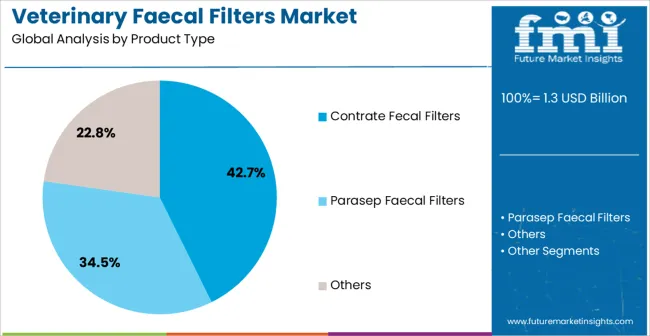
The contrate fecal filters segment is projected to hold 42.7% of the market revenue in 2025, establishing it as the leading product type. Its growth is driven by high efficiency in removing faecal matter and contaminants, which ensures better hygiene and reduces the risk of infections in veterinary settings. These filters are designed for durability, ease of installation, and low maintenance, making them suitable for high-volume veterinary operations and intensive livestock facilities.
Adoption is further supported by compatibility with standard waste management systems and the ability to handle varying types of faecal loads without compromising performance. Veterinary facilities benefit from enhanced sanitation, operational efficiency, and compliance with biosecurity protocols when using contrate fecal filters.
Continuous improvements in filtration technology, including advanced mesh structures and material enhancements, have reinforced reliability and effectiveness As the demand for hygiene-focused veterinary solutions grows, contrate fecal filters are expected to maintain market leadership, supported by proven performance, cost efficiency, and wide applicability across diverse veterinary and animal care environments.
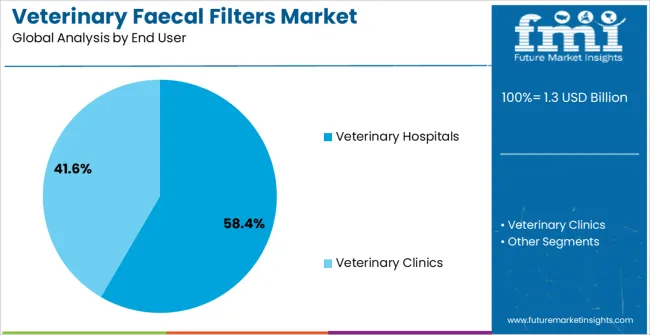
The veterinary hospitals end-user segment is anticipated to account for 58.4% of the market revenue in 2025, making it the largest end-user category. Growth in this segment is being driven by the need for maintaining strict hygiene standards and preventing cross-contamination in animal treatment areas. Veterinary hospitals handle a high volume of patients daily, requiring effective faecal filtration systems to reduce pathogen spread, ensure regulatory compliance, and provide a safe environment for both staff and animals.
Integration of faecal filters into operational protocols helps optimize cleaning processes and reduces labor costs associated with manual waste management. Awareness campaigns and professional guidelines emphasizing biosecurity in veterinary practices are further supporting adoption.
The increasing prevalence of zoonotic diseases and rising expectations for animal welfare have highlighted the importance of hygienic facilities, encouraging hospitals to invest in high-performance filtration systems As veterinary services expand globally, veterinary hospitals are expected to remain the primary end-user segment, driving demand for advanced, efficient, and reliable faecal filtration solutions.
Veterinary faecal filters have been developed in combination with leading veterinary institution and offer an improved technique for determining worm eggs count in cattle, horses and sheep. The veterinary faecal filters are enclosed system which offers to a user contact with clearner, contamination free environment and safer method of determining accurate worm egg counts with harmful aerosols and vapours.
A veterinary faecal filter consist all the filtration process such as shaking, mixing inside the tube which prevents the contamination and time consuming clean-up of shaker bottles, sinks and sieves. The veterinary faecal filters are single use devices which can be used in vitro setting.
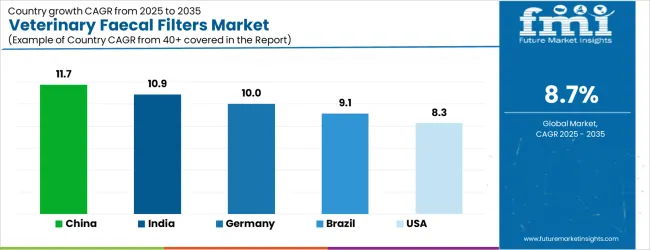
| Country | CAGR |
|---|---|
| China | 11.7% |
| India | 10.9% |
| Germany | 10.0% |
| Brazil | 9.1% |
| USA | 8.3% |
| UK | 7.4% |
| Japan | 6.5% |
The Veterinary Faecal Filters Market is expected to register a CAGR of 8.7% during the forecast period, exhibiting varied country level momentum. China leads with the highest CAGR of 11.7%, followed by India at 10.9%. Developed markets such as Germany, France, and the UK continue to expand steadily, while the USA is likely to grow at consistent rates.
Japan posts the lowest CAGR at 6.5%, yet still underscores a broadly positive trajectory for the global Veterinary Faecal Filters Market. In 2024, Germany held a dominant revenue in the Western Europe market and is expected to grow with a CAGR of 10.0%.
The USA Veterinary Faecal Filters Market is estimated to be valued at USD 487.5 million in 2025 and is anticipated to reach a valuation of USD 487.5 million by 2035. Sales are projected to rise at a CAGR of 0.0% over the forecast period between 2025 and 2035. While Japan and South Korea markets are estimated to be valued at USD 60.2 million and USD 45.0 million respectively in 2025.
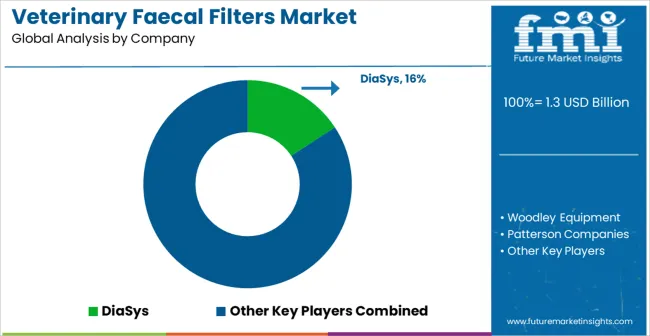
| Item | Value |
|---|---|
| Quantitative Units | USD 1.3 Billion |
| Product Type | Contrate Fecal Filters, Parasep Faecal Filters, and Others |
| End User | Veterinary Hospitals and Veterinary Clinics |
| Regions Covered | North America, Europe, Asia-Pacific, Latin America, Middle East & Africa |
| Country Covered | United States, Canada, Germany, France, United Kingdom, China, Japan, India, Brazil, South Africa |
| Key Companies Profiled | DiaSys, Woodley Equipment, Patterson Companies, Jorgensen Laboratories, Kruuse, Ritter Medical, MEGACOR Diagnostik, Bio-Techne, Weso - Med, and Interlab |
The global veterinary faecal filters market is estimated to be valued at USD 1.3 billion in 2025.
The market size for the veterinary faecal filters market is projected to reach USD 3.0 billion by 2035.
The veterinary faecal filters market is expected to grow at a 8.7% CAGR between 2025 and 2035.
The key product types in veterinary faecal filters market are contrate fecal filters, parasep faecal filters and others.
In terms of end user, veterinary hospitals segment to command 58.4% share in the veterinary faecal filters market in 2025.






Our Research Products

The "Full Research Suite" delivers actionable market intel, deep dives on markets or technologies, so clients act faster, cut risk, and unlock growth.

The Leaderboard benchmarks and ranks top vendors, classifying them as Established Leaders, Leading Challengers, or Disruptors & Challengers.

Locates where complements amplify value and substitutes erode it, forecasting net impact by horizon

We deliver granular, decision-grade intel: market sizing, 5-year forecasts, pricing, adoption, usage, revenue, and operational KPIs—plus competitor tracking, regulation, and value chains—across 60 countries broadly.

Spot the shifts before they hit your P&L. We track inflection points, adoption curves, pricing moves, and ecosystem plays to show where demand is heading, why it is changing, and what to do next across high-growth markets and disruptive tech

Real-time reads of user behavior. We track shifting priorities, perceptions of today’s and next-gen services, and provider experience, then pace how fast tech moves from trial to adoption, blending buyer, consumer, and channel inputs with social signals (#WhySwitch, #UX).

Partner with our analyst team to build a custom report designed around your business priorities. From analysing market trends to assessing competitors or crafting bespoke datasets, we tailor insights to your needs.
Supplier Intelligence
Discovery & Profiling
Capacity & Footprint
Performance & Risk
Compliance & Governance
Commercial Readiness
Who Supplies Whom
Scorecards & Shortlists
Playbooks & Docs
Category Intelligence
Definition & Scope
Demand & Use Cases
Cost Drivers
Market Structure
Supply Chain Map
Trade & Policy
Operating Norms
Deliverables
Buyer Intelligence
Account Basics
Spend & Scope
Procurement Model
Vendor Requirements
Terms & Policies
Entry Strategy
Pain Points & Triggers
Outputs
Pricing Analysis
Benchmarks
Trends
Should-Cost
Indexation
Landed Cost
Commercial Terms
Deliverables
Brand Analysis
Positioning & Value Prop
Share & Presence
Customer Evidence
Go-to-Market
Digital & Reputation
Compliance & Trust
KPIs & Gaps
Outputs
Full Research Suite comprises of:
Market outlook & trends analysis
Interviews & case studies
Strategic recommendations
Vendor profiles & capabilities analysis
5-year forecasts
8 regions and 60+ country-level data splits
Market segment data splits
12 months of continuous data updates
DELIVERED AS:
PDF EXCEL ONLINE
Veterinary Point of Care Diagnostics Market Size and Share Forecast Outlook 2025 to 2035
Veterinary Allergy Diagnostics Market Size and Share Forecast Outlook 2025 to 2035
Veterinary TSE Testing Market Size and Share Forecast Outlook 2025 to 2035
Veterinary Dermatology Market Forecast Outlook 2025 to 2035
Veterinary Telemedicine Market Size and Share Forecast Outlook 2025 to 2035
Veterinary Dietary Supplements Market Size and Share Forecast Outlook 2025 to 2035
Veterinary Imaging Market Forecast and Outlook 2025 to 2035
Veterinary CRISPR-Based Detection Kits Market Size and Share Forecast Outlook 2025 to 2035
Veterinary Pregnancy Test Kit Market Forecast and Outlook 2025 to 2035
Veterinary X-Ray Illuminators Market Size and Share Forecast Outlook 2025 to 2035
Veterinary Scales Market Size and Share Forecast Outlook 2025 to 2035
Veterinary Grooming Aids Market Size and Share Forecast Outlook 2025 to 2035
Veterinary Micro-fibre Endoscope Market Size and Share Forecast Outlook 2025 to 2035
Veterinary Dental Equipment Market Size and Share Forecast Outlook 2025 to 2035
Veterinary Rapid Test Market Size and Share Forecast Outlook 2025 to 2035
Veterinary Therapeutic Diet Market Size and Share Forecast Outlook 2025 to 2035
Veterinary Glucometers Market Size and Share Forecast Outlook 2025 to 2035
Veterinary Pain Management Drugs Market Size and Share Forecast Outlook 2025 to 2035
Veterinary Anesthesia Machines Market Size and Share Forecast Outlook 2025 to 2035
Veterinary Thermography Market Size and Share Forecast Outlook 2025 to 2035

Thank you!
You will receive an email from our Business Development Manager. Please be sure to check your SPAM/JUNK folder too.
Chat With
MaRIA